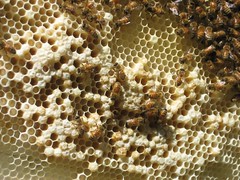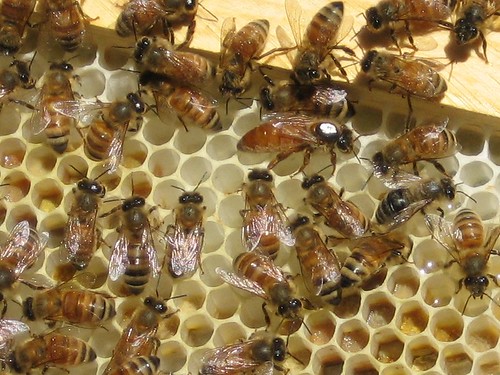For solace, I occasionally do things that I think will somehow promote my image in the hive as a benevolent god. Saturday was one such instance.
As you may remember, last week I put in five frames of somewhat moldy old comb into the hives, with the intention that they would clean them out and make them hospitable again. They seemed to be a doing a decent job of it, as I could see little piles of moldy wax and hardened pollen stacked outside their little doorway. But it’s a lot of work for them to haul out each piece of wax individually, so I thought I’d just exercise my monumental power as a 5’6″ human male and, with a single sweep of my massive hand, clean out the garbage that would otherwise take them a week or more to haul (or so I imagined).
 As you can see in the picture to the right, it really wasn’t such a big deal. They’d hauled out most of the debris themselves, and had a nice path around their little doorway (top right), but still I felt good clearing out the rest of the gunk you see (flecks of mold and wax). I checked the old frames and they had most of the grossness cleaned off it, just some areas on the outer edge they hadn’t gotten to yet.
As you can see in the picture to the right, it really wasn’t such a big deal. They’d hauled out most of the debris themselves, and had a nice path around their little doorway (top right), but still I felt good clearing out the rest of the gunk you see (flecks of mold and wax). I checked the old frames and they had most of the grossness cleaned off it, just some areas on the outer edge they hadn’t gotten to yet.
There was one unpleasant suprise, however. As you can see in the picture below, there was quite a few drone cells (identifiable by their tall, bullet-shape) on one of the frames. Drones are males and are distinguished from their female counterparts both by their slightly larger size and by their total and complete lack of ability to do anything productive beyond getting busy with a queen from a different hive, after which they die immediately (giving new meaning to the phrase petit mort). That’s it, that’s all they do.
Here’s another little oddity of the bee’s reproductive process: a queen bee can lay workers (females) or drones (males). Worker bees, however, while they can lay eggs, typically don’t, and, if they do, can only lay drones.
You might see lots of drone cells if there is either no queen (the workers will start laying eggs in a last ditch attempt to keep the hive going) or a virgin queen (queens will screw a ton of drones over a period of days, and keep their sperm stored up for years, doling it out to their eggs as needed, but can’t lay females until then).
This obviously had me a bit worried, so I rooted through a few of the frames until I found the queen, wobbling around on the third frame from the end. She’s usually tough to find, but the little spot of white paint they put on her back (below) is handy for picking her out.







